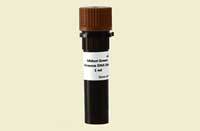MIDORI Green Xtra — Safe DNA Stain
Non-carcinogenic, Non-toxic, and Über-sensitive
Better sensitivity than EtBr … Guaranteed!
MIDORI Green Xtra is the newest addition to the family of MIDORI Green DNA stains from Nippon Genetics. Xtra is a highly sensitive green fluorescent stain for a safe visualization of DNA and RNA in agarose gels using either blue LEDs or our superior Blue/Green LED Gel Illuminators and Imagers. It is markedly superior to the traditional nucleic acid stain ethidium bromide (EtBr) in just about every way. Agarose gels stained with Xtra have an ultra-low background fluorescence, which makes the identification of even tiny amounts of DNA very easy. Free samples are available, so see for yourself how MIDORI Green Xtra provides safe detection with unbeatable sensitivity. See what Midori Green Xtra customers are saying.
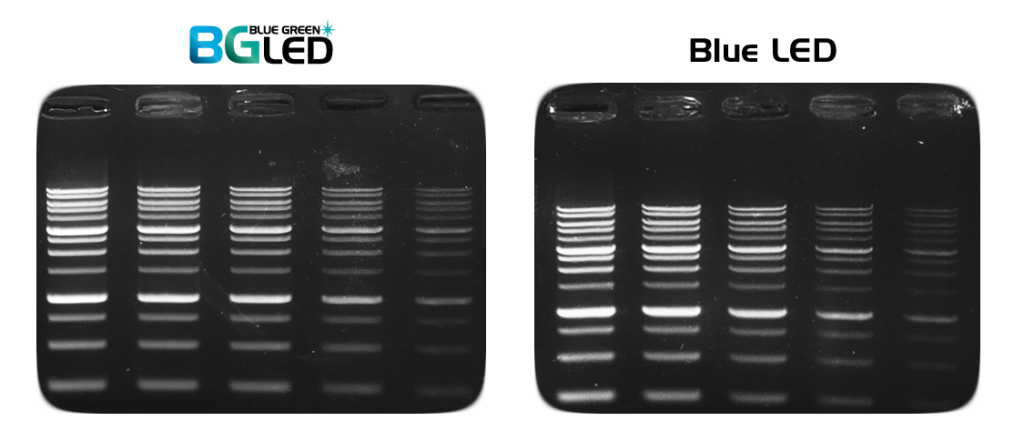
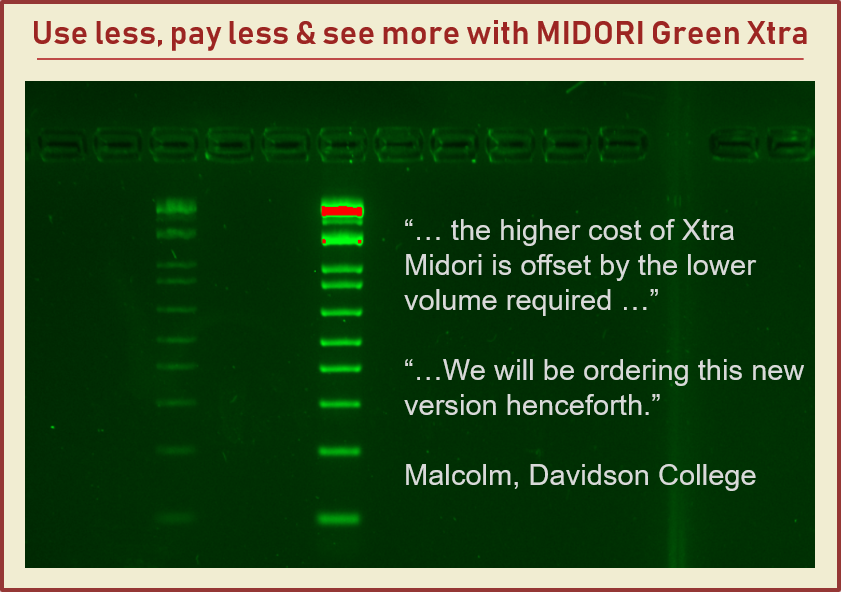
Thoroughly tested for your safety
Non-toxic. Non-mutagenic. MIDORI Green Xtra Nucleic Acid Stain is a new, safe alternative to traditional ethidium bromide(EtBr) stain for detecting dsDNA, ssDNA and RNA in agarose gels. Nearly identical to EtBr in performance and use, Xtra is much less harmful to living organisms. As compared with EtBr, known to be a strong mutagen; Xtra causes far fewer mutations in the Ames Test, the accepted industry standard for carcinogen and teratogen testing. High mutagenicity in this test is often linked to carcinogens and teratogens. Another side of safety is toxicity, and all Midori Green stains are non-toxic too! So they’re not hazardous waste; unlike EtBr and some other “safe DNA dyes”, and can be disposed of according to standard laboratory procedures, making use in the lab easy as well as safe for technical staff and students.
Three makes a happy family
The core MIDORI Green molecule has been formulated into three different green fluorescent stains optimized for your lab’s needs. First, there’s MIDORI Green Advance, which offers an excellent signal-to-noise ratio and solid sensitivity for even short nucleic acid fragments. MIDORI Green Advance is added into the agarose gel prior to running samples (much like EtBr), and provides sensitivity of detection on par with EtBr when visualized with blue LEDs or Nippon Genetics’ superior Blue/Green LED technology. The second, MIDORI Green Direct, is designed to mix with your sample and load onto a stain-free gel. MIDORI Green Direct has the loading dye included, and detects nucleic acid fragments to a similar, if not slightly better, level as MIDORI Green Advance. The newest member of the family is MIDORI Green Xtra/Easy. Like Advance, Xtra/Easy is added to molten agarose and buffer. It’s chemical structure is optimized for Blue/Green and Blue LED light, leading to unbeatable fluorescence signals of DNA and RNA in agarose gels. MIDORI Green Advance and MIDORI Green Direct dyes are compatible with UV-light, but slightly less efficient when using UV rather than the non-damaging visible excitation light of LEDs. Most importantly for labs, MIDORI Green Xtra/Easy does not stain the agarose gel, leading to an excellent signal-to-noise ratio. Xtra/Easy makes the detection of even the most minute quantities of DNA or RNA possible (and certainly better than EtBr)—it’s not just a replacement for EtBr, it’s an upgrade.

Safer for you and better for your subcloning
By using safe MIDORI Green dyes and safe Blue/Green LED illumination you can improve your subcloning transformation efficiencies by THREE-FOLD. In the example below, a plasmid vector was double digested with suitable restriction enzymes to create two sticky-ended DNA fragments: the lacZ gene (3,536 bp) and the backbone of the vector (4,318 bp). Equal amounts of digested DNA were electrophoresed on 1% agarose gels. The gels were stained with either ethidium bromide or MIDORI Green Direct gel stain according to the corresponding manuals, and then viewed using either a UV transilluminator or the FastGene Blue/Green LED Illuminator, respectively. The two DNA fragments were excised from the gels and purified using a silica membrane based purification kit. The lacZ gene and the vector backbone were re-ligated using T4 DNA ligase transformed into DH5a cells and plated onto selection plates. The total number of blue and white colonies was counted to evaluate cloning efficiency. Each experiment was conducted in triplicate, and the average cloning efficiency was determined. MIDORI Green Direct resulted in a dramatic increase of positive transformants.
Midori Green Can Boost Your Cloning Results!
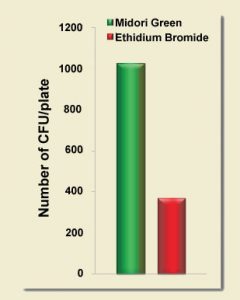
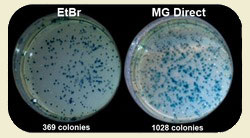
Ethidium bromide is typically used in conjunction with a strong UV light source to excise DNA bands for purification prior to the ligation reaction. Short-wavelength light is known to cause thymine dimers and damage DNA. The extent of this damage is not always appreciated. High-energy light wreaks havoc on DNA fragments in mere seconds. As can be seen below, cloning efficiency starts to drop after just a 15 second exposure of DNA in a standard agarose gel. After a 30 second exposure, your cloning experiment is all but dead! In contrast, the cloning efficiency of protocols that use blue LEDs or Nippon Genetics’ super-performing Blue/Green LEDs are completely unaffected by this deleterious effect. If your lab can’t to break itself of its ethidium bromide habit, using a Blue/Green LED Illuminator (or imaging system) should still have an immediate positive impact on DNA integrity and cloning efficiency.
UV Transilluminators Kill Cloning Experiments
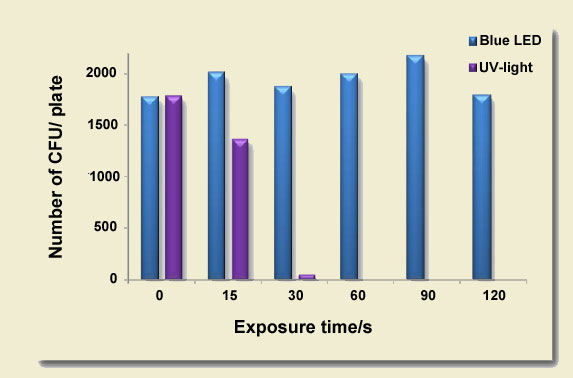
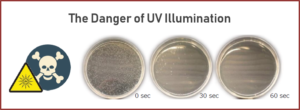
Additional Information
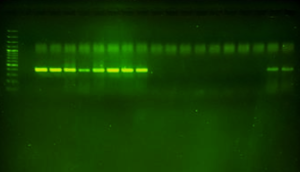
“After receiving a free sample of Midori Green Xtra from Bulldog Bio, my lab has fully made the switch to their product after years of using Invitrogen’s Syber Safe. Switching was the easiest choice to make! Midori is synonymous with regard to Syber Safe’s protocol; however, we use significantly less product and our gels have never looked better!”
Gabrielle, 2019
Old Dominion University
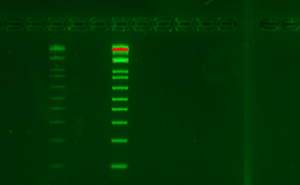
Malcolm, 2019
Davidson College
Midori Green Xtra DNA Stain
|
SPECIFICATIONS
|
|
|---|---|
| Part Number | MG10 |
| Contents | 1 mL tube (25,000x) |
| # of Gels | up to 250 gels (100 mL) |
| Add to Gel | Yes |
| Add to Sample | No |
| Post Staining | Yes |
| UV Transilluminator Compatible | No |
| Blue LED Illuminator Compatible | Yes |
| Blue/Green LED Illuminator Compatible | Yes, best choice |
| Excitation | 250 nm 482 nm |
| Emission | 509 nm |
| Toxicity | Non-toxic Non-carcinogenic Non-mutagenic |
| Storage | 1 Year in the dark at 4°C |


